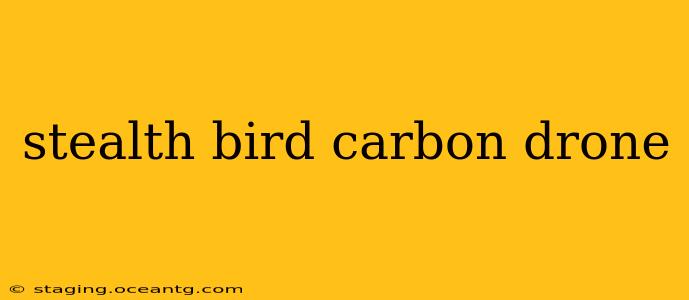The world of drones is constantly evolving, with manufacturers striving for lighter, faster, and quieter aircraft. The "Stealth Bird Carbon Drone" (assuming this refers to a drone utilizing carbon fiber construction and prioritizing silent flight) represents a significant leap towards achieving this goal. Carbon fiber, with its high strength-to-weight ratio, allows for the creation of drones that are both robust and lightweight, leading to improved flight characteristics and potentially quieter operation. This article will delve into the key aspects of a hypothetical Stealth Bird Carbon Drone, addressing common questions and exploring the technological advancements that make such a device possible.
What Makes a Carbon Fiber Drone Quieter?
The primary reason a carbon fiber drone might be quieter than its counterparts made from other materials lies in its lightweight nature. Lighter drones require less powerful motors to achieve the same level of thrust. Less powerful motors, in turn, generate less noise. The inherent stiffness of carbon fiber also contributes to reduced vibrations, further minimizing noise pollution. However, it's crucial to understand that "stealth" in the drone world is relative. While carbon fiber construction can significantly reduce noise, complete silence is practically impossible.
How Does Carbon Fiber Affect Drone Flight Performance?
The use of carbon fiber dramatically improves drone flight performance in several ways. Its high strength-to-weight ratio allows for longer flight times, as less energy is needed to lift and maneuver the drone. This also translates to faster speeds and enhanced maneuverability. The material's stiffness provides superior stability and reduces vibrations, leading to smoother and more precise flight control. These improvements are particularly crucial for applications requiring stealth and precision, such as aerial photography, surveillance, or search and rescue operations.
What are the Advantages of a Carbon Fiber Drone Compared to Other Materials?
Compared to drones made from materials like plastic or aluminum, carbon fiber drones offer several distinct advantages:
- Lightweight: Leading to longer flight times and increased maneuverability.
- High Strength: Ensuring durability and resistance to damage.
- Stiffness: Resulting in improved stability and reduced vibrations.
- Aerodynamic Efficiency: Contributing to better flight performance.
- Potential for Quieter Operation: Due to lighter motors and reduced vibrations.
Is a Carbon Fiber Drone More Expensive?
Yes, generally, carbon fiber drones are more expensive than those constructed from other materials. The cost of carbon fiber itself is higher, and the manufacturing process often requires specialized techniques and expertise. However, the superior performance and durability often justify the higher price for applications where these features are critical.
What are the Potential Uses of a Stealth Bird Carbon Drone?
The combination of stealth and high performance makes a hypothetical Stealth Bird Carbon Drone ideal for a range of applications, including:
- Aerial Photography and Videography: Capturing stunning footage without disturbing the subject.
- Surveillance and Monitoring: Discreetly observing areas of interest.
- Search and Rescue Operations: Quickly and quietly locating individuals in need.
- Precision Agriculture: Monitoring crops and livestock without causing disruption.
- Environmental Monitoring: Studying wildlife and ecosystems without disturbing natural habitats.
How Durable is a Carbon Fiber Drone?
Carbon fiber's inherent strength and stiffness make it remarkably durable. While not indestructible, a well-designed carbon fiber drone can withstand impacts and stresses that might damage drones made from other materials. However, proper handling and care are still essential to prolong its lifespan.
What are the Limitations of Carbon Fiber Drones?
Despite its advantages, carbon fiber also has limitations:
- Cost: As mentioned previously, carbon fiber drones are more expensive than alternatives.
- Repair Difficulty: Repairing damaged carbon fiber components can be challenging and may require specialized tools and expertise.
- Susceptibility to Impact Damage: While strong, carbon fiber can still be damaged by significant impacts.
This exploration of a hypothetical Stealth Bird Carbon Drone reveals the significant potential of carbon fiber in the development of quieter, more efficient, and versatile drones. As technology advances, we can expect to see even more sophisticated and capable drones built using this innovative material. The future of silent flight may well be written in carbon.
